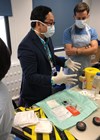This series explores the four pillars of advanced clinical practice and here, Jem Ann Bautista explores the pillar of clinical practice.
As day case theatre practitioners in one of London’s biggest and busiest centres, our team is trained to cater to a high-volume variety of elective cases. Additionally, we are also a main provider and coordinator of urgent ocular care. Both of these responsibilities are interesting but are admittedly often challenging as we have to work within shifting socioeconomic situations.
The Royal College of Ophthalmologists defines an urgent eye condition as one “that is of recent onset and is distressing or is believed by the patient, carer or referring health professional to present an imminent threat to vision or general health” [1]. The 10 most salient presentations that fall under the category of requiring emergency eyecare are:
- Chemical injury
- Severe pain or loss of vision within a week of surgery or intravitreal injection
- Sudden onset diplopia
- Sudden painful loss of vision
- Sudden painless loss of vision
- Painful loss of vision in contact lens wearer
- Painful loss of vision after glaucoma surgery or corneal graft surgery at any time
- Severe lid swelling with pyrexia
- Eye pain keeping patient awake at night
- Mechanical globe injuries [1] – mechanical globe injuries can be further classified as open or closed type [2].
It is estimated that more than half a million blinding injuries occur globally every year [3]. In the UK, the approximate rate for new eye casualty cases is about 20–30 per 1000 population annually, with eye emergencies amounting to 1.46–6% of A&E attendances [4]. Eye injuries are the top cause of monocular visual disability and acquired unilateral blindness among adults and children [3,5].
Changes in general practitioners’ out-of-hours contracts, the four-hour wait target, ageing population, as well as inconsistent number and availability of trained staff all add to the greater pressure currently seen in emergency eyecare units and general A&E departments [6].

A scrub trolley set up for an ophthalmic surgical procedure, representing how nurses weave their theoretical knowledge and practical skills together in caring for patients.
The Royal College of Ophthalmologists’ emergency eyecare guidance stipulates that triage systems have to be in place to minimise unwarranted hospital visits, and lead patients to appropriate pathways, especially if they need a rapid access referral to a subspecialty. In a hospital setting, it is set forth that staff cover and availability (doctors, nurses, allied health professionals, and administrative staff), well-defined networks, equipment and investigation tools, and a safeguarding team are essential components of an emergency eye service [4].
Assuring that all of these components are all set every time is a challenge that frontline practitioners and unit managers have to tackle frequently. In our case, as an operating theatre department in a day unit, it is critical that the team regularly reviews past experiences, current trends, and forecasts to ensure responsive and proactive measures are in position.
The demand and expectation from day surgery and ambulatory units are evolving, especially after the onslaught of the recent pandemic. It has been realised that with technological and medical advances, these services have a huge contributing potential in putting balance back between demand and capacity in publicly funded institutions.
New treatment options that aim to lessen patients’ need for frequent hospital attendances are continuously being discovered, trialled, and applied. Additionally, surgeries that were exclusively offered as in-patient modalities before are now increasingly being turned into same-day procedures with careful patient selection criteria.
The role of ophthalmic nurses in managing this demand for a reliable emergency eye service cannot be emphasised enough. Nurse practitioners are noted to be a more stable workforce in A&E, minor injury units, and walk-in centres, with their presence being proportionate to the capacity of these departments in dealing with high-volume, lower-risk cases [6]. We also play a central role in organising, coordinating, and leading educational and training programmes, streamlining patient pathways and service protocols, as well as using our clinical and managerial knowledge in advocating for more appropriate use of resources.
Overall, emergency ocular health problems pose economic and social burden to individual patients and to the wider community. It also compounds on the already substantial pressure felt by teams in treating progressive and long-standing ophthalmic conditions. The demand for services to cater to these is not expected to dwindle in the coming years. But there is something we can all do to address it.
Educating the public, implemented widely, remains as one of the fundamental but effective means of guiding people as to what services are available to them as well as where and how to access these. Active information dissemination in schools, workplaces, and recreational venues about ocular health and safety can also contribute to decreasing the likelihood of new cases.
Within primary and secondary centres, we can begin by placing focus within our respective departments on ensuring our networks and standard operating procedures are up to date; recruitment, training, and cross-skilling of staff is kept as a positive experience for all; and ascertaining audits, incidents, and service reviews are performed regularly.
FOR MORE INFORMATION
The Royal College of Nursing (RCN) Ophthalmic Nursing Committee promotes eye health, education, and service leadership. To visit the RCN Ophthalmic Nursing Forum website for news and how to become a member click here
References
1. Emergency Eye Care Commissioning Guidance. The Royal College of Ophthalmologists (2020).
https://www.rcophth.ac.uk/resources-listing/
emergency-eye-care-commissioning-guidance
2. Mutie D, Mwangi N. Assessing an eye injury patient. Comm Eye Health 2015;28(91):46.
3. Merca TGB, Valbuena M. Epidemiology and visual outcomes of pediatric ocular trauma cases in a tertiary hospital. Philipp J Ophthalmol 2014;39(1):27–32.
4. Ophthalmic Service Guidance: Emergency eye care in hospital eye units and secondary care. The Royal College of Ophthalmologists (2024).
https://www.rcophth.ac.uk/wp-content/uploads/
2021/01/Emergency-eye-care-in-hospital-eye
-units-and-secondary-care-Copy.pdf
5. Ababneh LT, Mohidat H, Abdelnabi H, et al. Hospital-based ocular trauma: Factors, treatment, and impact outcome. Clin Ophthalmol 2019;13:2119–26.
6. The Way Forward: Options to meet demand for the current and future care of patients with eye disease. Royal College of Ophthalmologists (2017).
https://www.rcophth.ac.uk/wp-content/uploads/
2017/01/RCOphth-The-Way-Forward-Emergency-Eye-Care-300117.pdf
[All links last accessed February 2025]
Declaration of competing interests: None declared.









